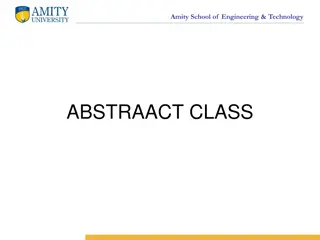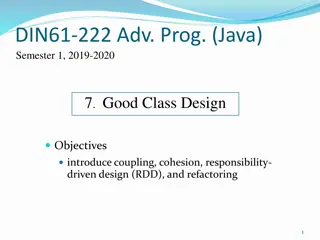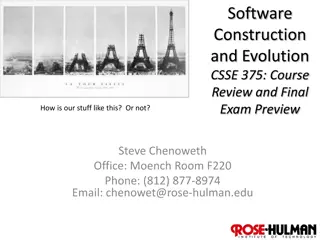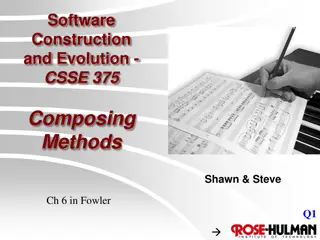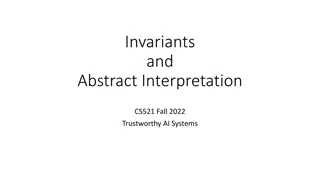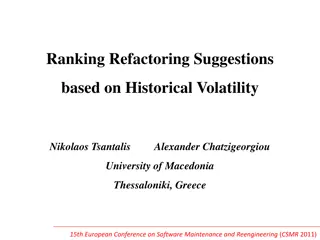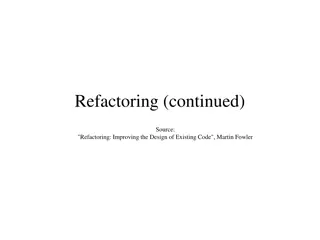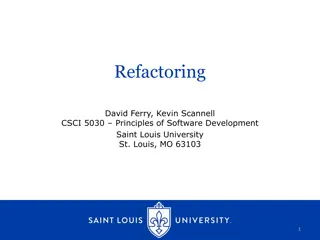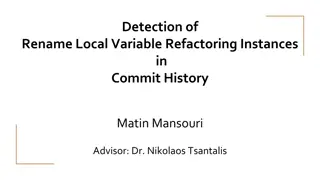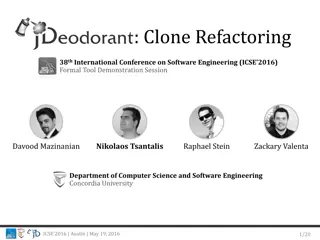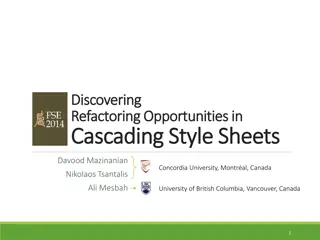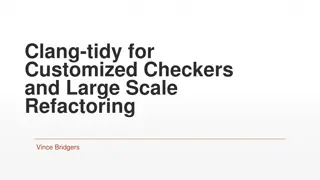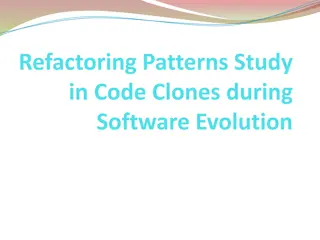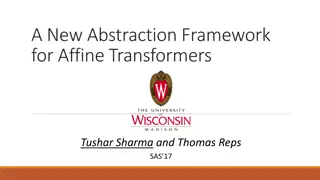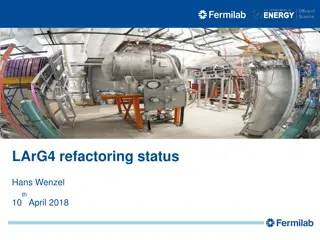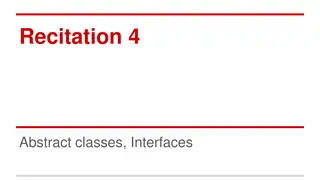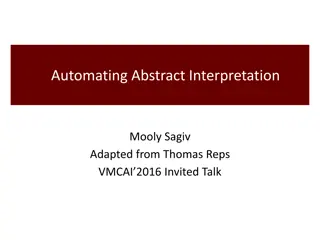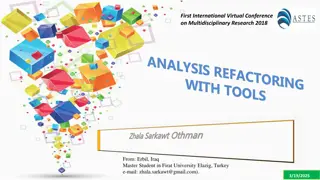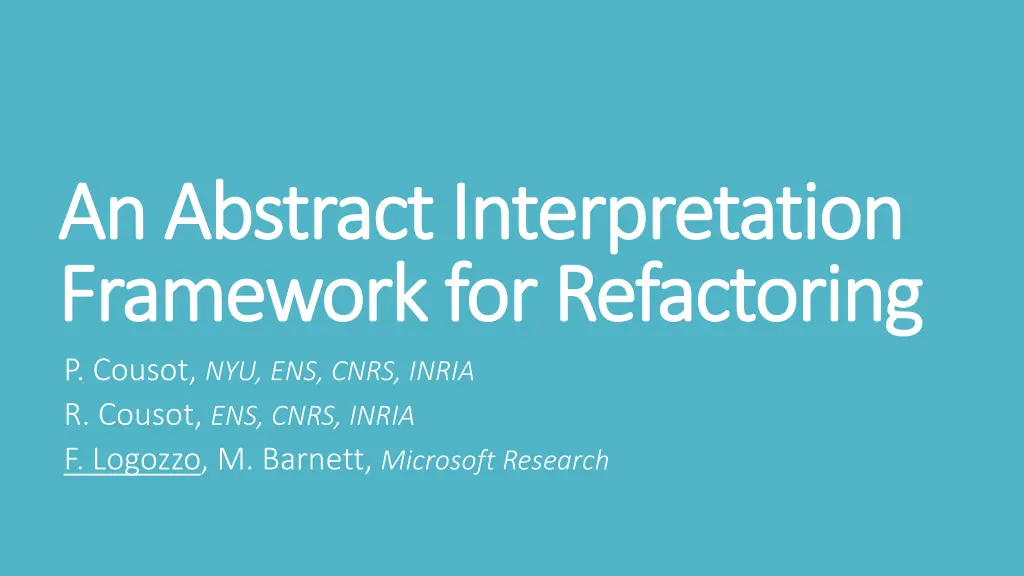
Interpretation Framework for Refactoring
"Explore an abstract interpretation framework for proof-preserving method refactoring in programming, addressing challenges in code maintenance and correctness proof preservation. Learn about solutions like method inlining and user-assisted contracts. Implementation on real systems using CodeContracts and Roslyn CTP for comparable performance."
Download Presentation

Please find below an Image/Link to download the presentation.
The content on the website is provided AS IS for your information and personal use only. It may not be sold, licensed, or shared on other websites without obtaining consent from the author. If you encounter any issues during the download, it is possible that the publisher has removed the file from their server.
You are allowed to download the files provided on this website for personal or commercial use, subject to the condition that they are used lawfully. All files are the property of their respective owners.
The content on the website is provided AS IS for your information and personal use only. It may not be sold, licensed, or shared on other websites without obtaining consent from the author.
E N D
Presentation Transcript
An Abstract Interpretation An Abstract Interpretation Framework for Refactoring Framework for Refactoring P. Cousot, NYU, ENS, CNRS, INRIA R. Cousot, ENS, CNRS, INRIA F. Logozzo, M. Barnett, Microsoft Research
The problem Refactoring is a very common programmer activity Useful to maintain the code, avoid code bloat, etc. Examples: rename, re-order parameters, extract method, etc. IDEs guarantee that the refactored program is: 1. a syntactically valid program 2. a semantically equivalent program There is no guarantee about the 1. Preservation of the correctness proof 2. Interaction with the static analysis
Example: extract method public int Decrement(int x) { Contract.Requires(x >= 5); Contract.Ensures(Contract.Result<int>() >= 0); public int Decrement(int x) { Contract.Requires(x >= 5); Contract.Ensures(Contract.Result<int>() >= 0); while (x != 0) x--; x = NewMethod(x); return x; } return x; } private static int NewMethod(int x) { while (x != 0) x--; return x; }
and the (modular) proof? public int Decrement(int x) { Contract.Requires(x >= 5); Contract.Ensures(Contract.Result<int>() >= 0); public int Decrement(int x) { Contract.Requires(x >= 5); Contract.Ensures(Contract.Result<int>() >= 0); Postcondition: ok Postcondition Violation? while (x != 0) x--; x = NewMethod(x); No return x; } return x; } overflow private static int NewMethod(int x) { while (x != 0) x--; return x; } Possible overflow
Simple solutions? Method inlining: the reverse of extract method May not scale up, how many levels should we inline? Isolated analysis: infer pre- and postconditions of the extracted method Too imprecise, without the context inferred contracts may be too generic Invariant projection: project the pre/post-states on the parameters and return value Too specific, cannot refactor unreached code User assistance: User provides the contracts Impractical, too many contracts to write State of the art (before this paper ;-)
Contribution An abstract interpretation framework for proof-preserving method refactoring A new set theoretic version of Hoare logic With some surprising results! Definition of the problem of extract method with contracts Solution in the concrete and in the abstract Implementation on a real system Using the CodeContracts static verifier (Clousot) and the Roslyn CTP Performance comparable to the usual extract method
Extract method with contracts: Requirements
Validity The inferred contract should be valid Counterexample: public int Decrement(int x) { Contract.Requires(x >= 5); Contract.Ensures(Contract.Result<int>() >=0); private static int NewMethod(int x) { Contract.Requires(x >= 5); Contract.Ensures(Contract.Result<int>()==12345); Invalid ensures x = NewMethod(x); while (x != 0) x--; return x; } ok return x; }
Safety The precondition of the extracted method should advertise possible errors Counterexample: public int Decrement(int x) { Contract.Requires(x >= 5); Contract.Ensures(Contract.Result<int>() >=0); private static int NewMethod(int x) { Contract.Ensures(Contract.Result<int>() == 0); x = NewMethod(x); while (x != 0) x--; return x; } Possible overflow ok return x; }
Completeness The verification of the callee should still go through Counterexample: Valid and safe contract, but not complete public int Decrement(int x) { Contract.Requires(x >= 5); Contract.Ensures(Contract.Result<int>() >=0); private static int NewMethod(int x) { Contract.Requires(x >= 5); Contract.Ensures(Contract.Result<int>() <= x); Can t prove ensures x = NewMethod(x); while (x != 0) x--; return x; } ok return x; }
Generality The inferred contract is the most general satisfying Validity, Safety, and Completeness Counterexample: Valid, Safe, Complete but not General contract public int Decrement(int x) { Contract.Requires(x >= 5); Contract.Ensures(Contract.Result<int>() >=0); private static int NewMethod(int x) { Contract.Requires(x >= 5); Contract.Ensures(Contract.Result<int>() == 0); Requires too strong x = NewMethod(x); while (x != 0) x--; return x; } ok ok return x; }
Our solution Valid, Safe, Complete, and General contract public int Decrement(int x) { Contract.Requires(x >= 5); Contract.Ensures(Contract.Result<int>() >=0); private static int NewMethod(int x) { Contract.Requires(x >= 0); Contract.Ensures(Contract.Result<int>() == 0); x = NewMethod(x); while (x != 0) x--; return x; } ok ok return x; }
Algebraic Hoare Logic We need to formalize what a static analyzer does, in particular method calls Hoare Logic is the natural candidate However, it is already an abstraction of the concrete semantics We define a concrete Hoare logic where predicates are replaced by sets P ( ) and Q ( ) { P} S { Q } The deduction rules are as usual Details in the paper
Orders on contracts Covariant order Intuition: a stronger precondition is better for the callee P, Q P , Q iff P P and Q Q Contravariant order Intuition: a -stronger contract is more general (better for the caller) P, Q P , Q iff P P and Q Q Note: formal (and more correct) definition in the paper
Some notation m is the refactored (extracted) method Sdenotes the selected code (to be extracted) It is the body of the extracted method m Pm, Qm is the most precise safety contract for a method m See Cousot, Cousot & Logozzo VMCAI 11 Ps, Qs is the projection of the abstract state before the selection, Ps after the selection, Qs
Extract method with contracts problem The refactored contract PR, QR is a solution to the problem if it satisfies Validity { PR } S { QR } Safety PR,QR Pm, Qm Completeness PR,QR PS,QS so that { Ps } m( ) { Qs } Generality P R,Q R satisfying validity, safety, and completeness: PR,QR P R,Q R Theorem: The 4 requirements above are mutually independent
Declarative Solution Theorem: There exists a unique solution for the problem: PR,QR = Pm, post[S]Pm Drawback: It is not a feasible solution Pm and post[.] are not computable (only for trivial cases of finite domains) We need to perform some abstraction to make it tractable The formulation above is ill-suited for abstraction
Iterative Solution Idea: give an iterative characterization of the declarative solution It is easier to abstract and compensates for the lose of precision Theorem: Define F[S] X, Y = Pm pre~[S]Y, Qm post[S]X Then PR,QR = Pm,post[S]Pm = gfp(Ps, Qs) F[S] The order for the greatest fixpoint computation is Intuition: improve the contract at each iteration step By weakening the precondition and strengthening the postcondition
Abstract Hoare triples Given abstract domains A approximating ( ) and B approximating ( ) Define abstract Hoare triples { P } S { Q } { A(P) } S { B(Q) } Idea: replace the concrete set operations with the abstract counterparts Abstract Hoare triples generalize usual Hoare logic Example: Fix A, B to be first order logic predicates Question: Are the usual rules of Hoare logic valid in the general case?
Counterexample: conjunction rule { x 0 } x = -x { x 0 } and { x 0 } x = -x { x 0 } { x 0 x 0 } x = -x { x 0 x 0} { x = 0 } x = -x { false}
We are in trouble? A similar result holds for the disjunction rule We need some hypotheses on the abstract domains and the concretizations Theorem: The abstract Hoare triples without the conjunction and disjunction are sound But we need conjunction to model method call, product of analyses, etc.! Theorem: If B is finite-meet preserving the conjunction rule is sound A dual result holds for A and the disjunction rule Details on the paper: formalization and some extra technical details
And now? We can define the problem of the extract method with contracts in the abstract Define abstract contracts, the rule for abstract method call, etc. Theorem: The abstract counterparts for validity, safety, and completeness are sound However, abstraction introduces new problems It is impossible to have a complete abstract refactoring in general Need more hypotheses It did not manifest in our experiments The iterated gfp computation balances for the loss of information Use narrowing to enforce convergence Details in the paper (or come to see me after the talk!)
Implementation We use the CodeContracts static checker (aka Clousot) as underlying static analyzer Based on abstract interpretation More then 75K downloads, widely used in industrial environments We use the Roslyn CTP for C# language services and basic engine refactoring Industrial strength C# compiler and services implementation Integrates in Visual Studio
Inference Algorithm Use the Roslyn refactoring service to detect the extracted method m Use Clousot to infer Ps, Qs Project the entry state on the beginning of the selection(Ps). Similarly for Qs Annotate the extracted method with Ps, Qs Use Clousot to infer Pm, Qm Add Pm, Qm to the extracted method and start the abstract gfp computation Use Clousot for the abstract semantics Weaken the precondition, strengthen the postcondition Preserve Ps, Qs
Conclusions? Have an abstract interpretation framework to define proof-preserving refactorings En passant, generalized Hoare logic Found counterintuitive examples of unsoundness Instantiated to the problem of refactoring with contracts In the concrete: One solution, two formulations In the abstract: Completeness and generality only under some conditions Implementation on the top of industrial strength tools Come see our demo!!! demo!!!


